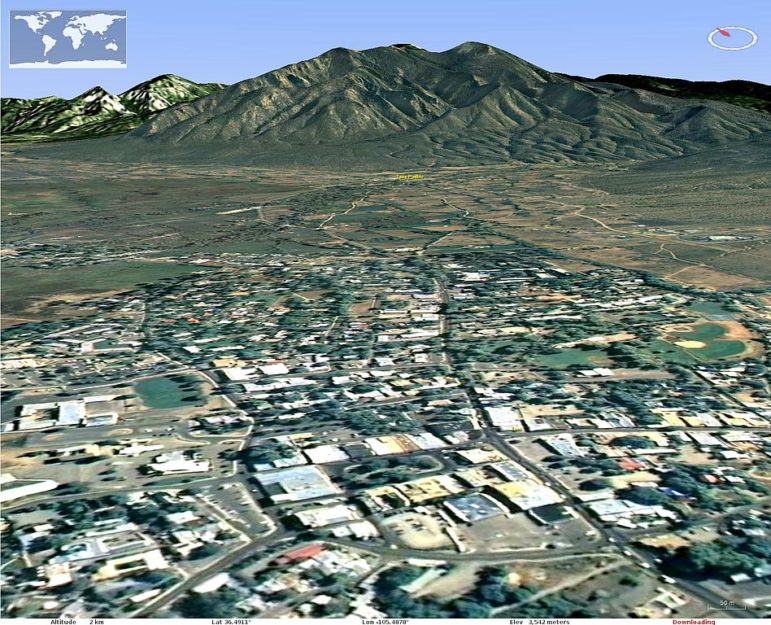
Wikipedia
.
It’s November 2019, and the hysteria from the emergency meeting in 2013 is still palpable for Yasmin Haque. After then-New Mexico Gov. Susana Martinez made the call to suspend Medicaid reimbursements to 15 statewide private behavioral health service providers, panicked Taos community members gathered at the former Casa de Corazón.
“Everyone was shell-shocked. We all wondered what we were going to do with these families,” said Haque, Court Appointed Special Advocate (CASA) volunteer coordinator at Taos-based child advocacy group Youth Heartline. “It was devastating. I would say we’re still struggling to recover.”
The Medicaid-funded Tri-County Community Services, which delivered key mental health and addiction counseling services to vulnerable populations in Taos, Colfax and Union counties, held on for as long as possible before shuttering in August 2018.
“Kids that had [behavioral management specialist] workers were suddenly gone and here were all of these new people and services coming in from Arizona,” she said. “We’ve had a lot of change in terms of therapeutic services and I think it’s slowly getting built back up, but it’s a long way away.”
Critics say that Martinez’s accusations of fraud and Medicaid overbilling against private mental health providers, which the state Attorney General’s Office couldn’t substantiate, pulverized the state’s already broken child welfare and foster care systems, with helpless children bearing the brunt of the negative effects. According to a 2017 report by the Children’s Bureau of the U.S. Department of Health and Human Services, the state’s child abuse rate started to gradually rise in 2014, and hit a record high of 25 kids per 1,000 children in 2017, nearly twice the national average.
Overall, New Mexico is failing its children. The Annie E. Casey Foundation Kids Count report, which aggregates a number of state trends in child well-being, ranging from child poverty and health insurance rates to math and reading proficiencies, ranked the state last in the country in overall child well-being in 2017 and 2018.
Scarcities
The local CASA program suffers from a lack of volunteers — “we have 16 between all three counties, and I’m being generous when I say that,” said Haque. As of June 2019, there were 56 youth in care in Taos, Colfax, and Union counties, according to a quarterly report published by the New Mexico Children, Youth, and Families Department.
Youth Heartline cares for abused and neglected children in Taos, Colfax and Union counties, and recruits and trains volunteers to be advocates for a youth in care in children’s court. The Taos and Raton branches of CASA, a national agency headquartered in Seattle, provides support for foster youth in the state’s Eighth Judicial District.
Additionally, youth in care in the three area counties are acutely challenged by a shortage of foster families and a scarcity of affordable places to live. “An inquiry we get all the time is about housing. We’re not equipped to offer that service because there isn’t any housing,” Haque said. “It’s unfortunate because if you don’t have housing, how are you going to get your children back from CYFD?”
CYFD’s child protective services division, as of June 2019, cared for 2,380 youth across the state. Overworked and understaffed, it tries to protect vulnerable kids. According to several court filings, it instead re-traumatizes endangered children who are in state care. But lawmakers and child advocacy groups are encouraged by Gov. Michelle Lujan Grisham’s edict to safeguard New Mexico youth from further woes. In January, she appointed Brian Blalock to CYFD cabinet secretary, giving him the job of reforming the foster care system.
[Related: New Mexicans See Foster Care Challenges, But Are Encouraged by Changes]
[Related: In Santa Fe, NM, ‘We’re Not Going to Play the Blame Game’]
[Related: Provider In Las Cruces, NM, Left Stretched Thin After 2013 Ruling]
[Related: Carlsbad, NM, Oil Windfall Makes It Harder to Keep Caseworkers]
At the same time, state lawmakers took Grisham’s directive and passed several foster care improvements during the 2019 New Mexico Legislature, including extending the eligibility for foster care services from age 18 to 21 and giving youth in care partial earned transfer credits if they move from school to school.
Haque remains concerned for kids who require specialized behavioral health services, especially because most educators aren’t trained to help children with complex trauma.
“That’s a huge thing because we have some children who have really struggled in the classroom,” she said. “We just had a very recent case where a child needs support 24/7 and there isn’t any.” She also sees a local need for supplementary adult protective services, especially for people who battle cognitive issues.
Despite the multifaceted challenges, Haque says that Youth Heartline’s CASA team is able to help youth in care due to healthy relationships with children’s lawyers, respondent attorneys and with Eighth Judicial District Court Chief Judge Emilio Chavez.
“He takes the time with the families to explain what’s going on because it’s very complicated and very scary,” Haque said. “They’re at the worst times in their lives because you’ve had a child removed and it’s very overwhelming. He’s very patient and encouraging and takes the time to explain the process.
“I think what’s really great about Taos is the approach,” Haque said. “We’re a team and we’re here to help families. We’re not trying to be punitive. It’s about supporting and helping the families to get the best outcomes for these kids and their families.”
This story is part of a Youth Today project on foster care in New Mexico. It’s made possible in part by the May and Stanley Smith Charitable Trust. Youth Today is solely responsible for the content and maintains editorial independence.





























